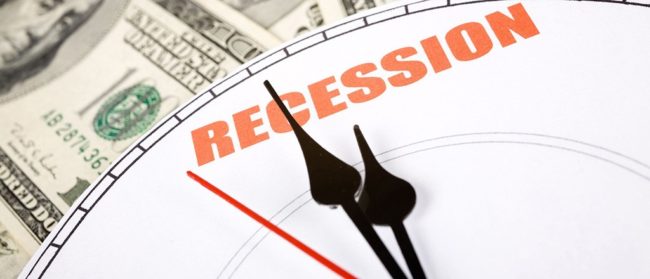Recession indicators which overwhelmingly signal a major economic slowdown brought on by slower growth abroad and Trump’s escalating trade war with China include:
- The U.S. bond market and the inverted yield curve — the yield on the benchmark 10-year Treasury note has fallen below the 2-year yield multiple times in the last month, and this inversion has preceded the last 7 recessions.
- Gross domestic product in the U.S. is slowing. The economy expanded by 2% in the second quarter, which is the lowest growth rate since the fourth quarter of 2018 and down from 3% growth in the first three months of this year.
- Corporate Earnings growth estimates have come down drastically this year from previous estimates for the S&P of 7.6% to current estimates of 2.3%.
- U.S. manufacturer growth slowed to the lowest level in almost 10 years in August, such that the reading is below the neutral 50.0 threshold for the first time since September 2009. Any reading below 50 signals a contraction. The Trump/China trade war, coinciding with global growth worries, continues “to weigh on business confidence and firms’ capital expenditure plans,” according to minutes from the Fed’s July meeting.
- The economic outlook from Freight’s perspective looks grim, as the Cass Shipments Index fell 5.9% in July, following a 5.3% decline in June and a 6% drop in May, “signaling an economic contraction,” the July report said, and “we see a growing risk that GDP will go negative by year’s end.”
- Copper, known as a barometer of economic health because of its use in homebuilding and commercial construction, is down over 13% in the last half year.
- Gold prices have soared more than 20% since May when and Trump and China escalated their tariff fight. Similar to government bonds, gold is known as a safe haven trade in times of economic uncertainty.
- The Global Economic Policy Uncertainty Index, an index designed to measure policy-related worries around the world, hit its all-time highest level, 342, in June.
- Business spending tumbled 5.5% in the second quarter, the worst since the fourth quarter of 2015, according to the Commerce Department’s quarterly GDP report. Coming off of a sugar high from Trump’s 2017 tax windfall, businesses are hesitant to invest in future initiatives due to uncertainty.
- Confidence in US policymakers has reached historic lows, while wealth becomes increasing concentrated and wages stagnate.


